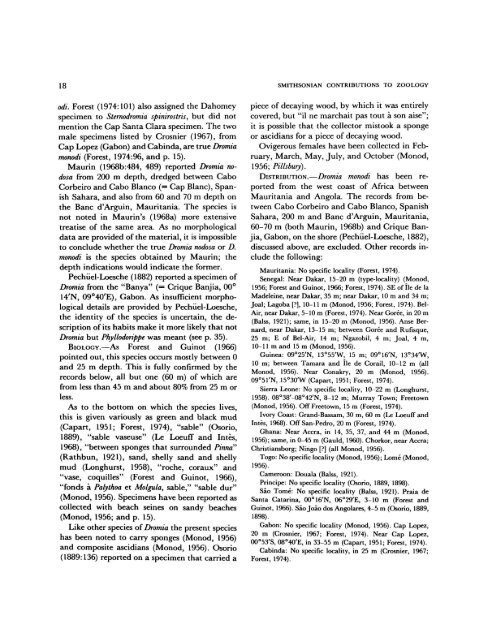West African Brachyuran Crabs - Smithsonian Institution Libraries
West African Brachyuran Crabs - Smithsonian Institution Libraries
West African Brachyuran Crabs - Smithsonian Institution Libraries
You also want an ePaper? Increase the reach of your titles
YUMPU automatically turns print PDFs into web optimized ePapers that Google loves.
18<br />
odi. Forest (1974:101) also assigned the Dahomey<br />
specimen to Sternodromia spinirostris, but did not<br />
mention the Cap Santa Clara specimen. The two<br />
male specimens listed by Crosnier (1967), from<br />
Cap Lopez (Gabon) and Cabinda, are true Dromia<br />
monodi (Forest, 1974:96, and p. 15).<br />
Maurin (1968b:484, 489) reported Dromia nodosa<br />
from 200 m depth, dredged between Cabo<br />
Corbeiro and Cabo Blanco (= Cap Blanc), Spanish<br />
Sahara, and also from 60 and 70 m depth on<br />
the Bane d'Arguin, Mauritania. The species is<br />
not noted in Maurin's (1968a) more extensive<br />
treatise of the same area. As no morphological<br />
data are provided of the material, it is impossible<br />
to conclude whether the true Dromia nodosa or D.<br />
monodi is the species obtained by Maurin; the<br />
depth indications would indicate the former.<br />
Pechiiel-Loesche (1882) reported a specimen of<br />
Dromia from the "Banya" (= Crique Banjia, 00°<br />
14'N, 09°40'E), Gabon. As insufficient morphological<br />
details are provided by Pechiiel-Loesche,<br />
the identity of the species is uncertain, the description<br />
of its habits make it more likely that not<br />
Dromia but Phyllodorippe was meant (see p. 35).<br />
BIOLOGY.—As Forest and Guinot (1966)<br />
pointed out, this species occurs mostly between 0<br />
and 25 m depth. This is fully confirmed by the<br />
records below, all but one (60 m) of which are<br />
from less than 45 m and about 80% from 25 m or<br />
less.<br />
As to the bottom on which the species lives,<br />
this is given variously as green and black mud<br />
(Capart, 1951; Forest, 1974), "sable" (Osorio,<br />
1889), "sable vaseuse" (Le Loeuff and Intes,<br />
1968), "between sponges that surrounded Pinna"<br />
(Rathbun, 1921), sand, shelly sand and shelly<br />
mud (Longhurst, 1958), "roche, coraux" and<br />
"vase, coquilles" (Forest and Guinot, 1966),<br />
"fonds a Palythoa et Moigula, sable," "sable dur"<br />
(Monod, 1956). Specimens have been reported as<br />
collected with beach seines on sandy beaches<br />
(Monod, 1956; and p. 15).<br />
Like other species of Dromia the present species<br />
has been noted to carry sponges (Monod, 1956)<br />
and composite ascidians (Monod, 1956). Osorio<br />
(1889:136) reported on a specimen that carried a<br />
SMITHSONIAN CONTRIBUTIONS TO ZOOLOGY<br />
piece of decaying wood, by which it was entirely<br />
covered, but "il ne marchait pas tout a son aise";<br />
it is possible that the collector mistook a sponge<br />
or ascidians for a piece of decaying wood.<br />
Ovigerous females have been collected in February,<br />
March, May, July, and October (Monod,<br />
1956; Pillsbury).<br />
DISTRIBUTION.—Dromia monodi has been reported<br />
from the west coast of Africa between<br />
Mauritania and Angola. The records from between<br />
Cabo Corbeiro and Cabo Blanco, Spanish<br />
Sahara, 200 m and Bane d'Arguin, Mauritania,<br />
60-70 m (both Maurin, 1968b) and Crique Banjia,<br />
Gabon, on the shore (Pechiiel-Loesche, 1882),<br />
discussed above, are excluded. Other records include<br />
the following:<br />
Mauritania: No specific locality (Forest, 1974).<br />
Senegal: Near Dakar, 15-20 m (type-locality) (Monod,<br />
1956; Forest and Guinot, 1966; Forest, 1974). SE of lie de la<br />
Madeleine, near Dakar, 35 m; near Dakar, 10 m and 34 m;<br />
Joal; Lagoba [?], 10-11 m (Monod, 1956; Forest, 1974). Bel-<br />
Air, near Dakar, 5-10 m (Forest, 1974). Near Goree, in 20 m<br />
(Balss, 1921); same, in 15-20 m (Monod, 1956). Anse Bernard,<br />
near Dakar, 13-15 m; between Goree and Rufisque,<br />
25 m; E of Bel-Air, 14 m; Ngazobil, 4 m; Joal, 4 m,<br />
10-11 m and 15 m (Monod, 1956).<br />
Guinea: 09°25'N, 13°55'W, 15 m; 09°16'N, 13°34'W,<br />
10 m; between Tamara and lie de Corail, 10-12 m (all<br />
Monod, 1956). Near Conakry, 20 m (Monod, 1956).<br />
09°51'N, 15°30'W (Capart, 1951; Forest, 1974).<br />
Sierra Leone: No specific locality, 10-22 m (Longhurst,<br />
1958). 08°38'-08°42'N, 8-12 m; Murray Town; Freetown<br />
(Monod, 1956). Off Freetown, 15 m (Forest, 1974).<br />
Ivory Coast: Grand-Bassam, 30 m, 60 m (Le Loeuff and<br />
Intes, 1968). Off San-Pedro, 20 m (Forest, 1974).<br />
Ghana: Near Accra, in 14, 35, 37, and 44 m (Monod,<br />
1956); same, in 0-45 m (Gauld, 1960). Chorkor, near Accra;<br />
Christiansborg; Ningo [?] (all Monod, 1956).<br />
Togo: No specific locality (Monod, 1956); Lome (Monod,<br />
1956).<br />
Cameroon: Douala (Balss, 1921).<br />
Principe: No specific locality (Osorio, 1889, 1898).<br />
Sao Tome: No specific locality (Balss, 1921). Praia de<br />
Santa Catarina, 00°16'N, 06°29'E, 3-10 m (Forest and<br />
Guinot, 1966). Sao Joao dos Angolares, 4-5 m (Osorio, 1889,<br />
1898).<br />
Gabon: No specific locality (Monod, 1956). Cap Lopez,<br />
20 m (Crosnier, 1967; Forest, 1974). Near Cap Lopez,<br />
OO°53'S, 08°40'E, in 33-55 m (Capart, 1951; Forest, 1974).<br />
Cabinda: No specific locality, in 25 m (Crosnier, 1967;<br />
Forest, 1974).

















